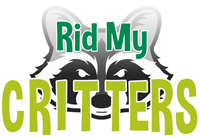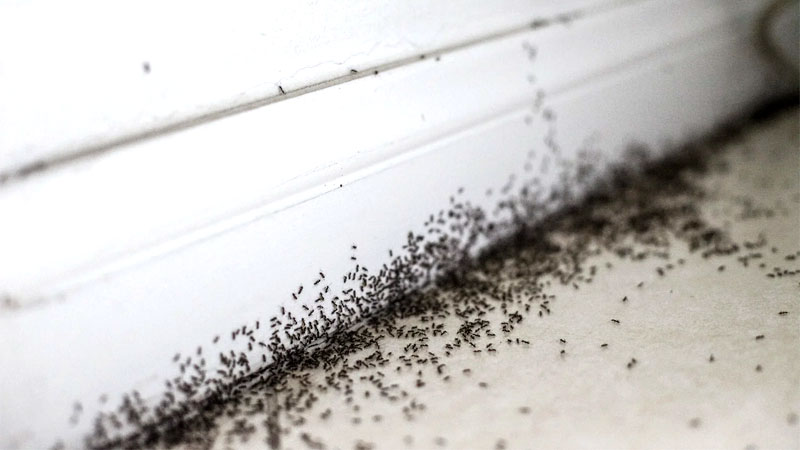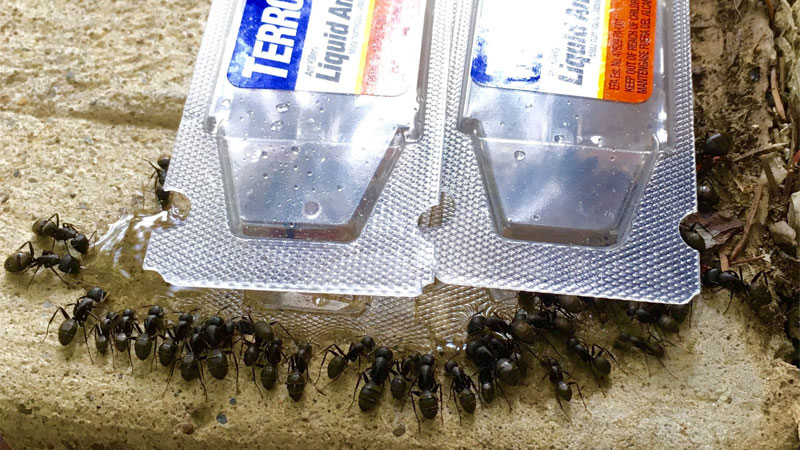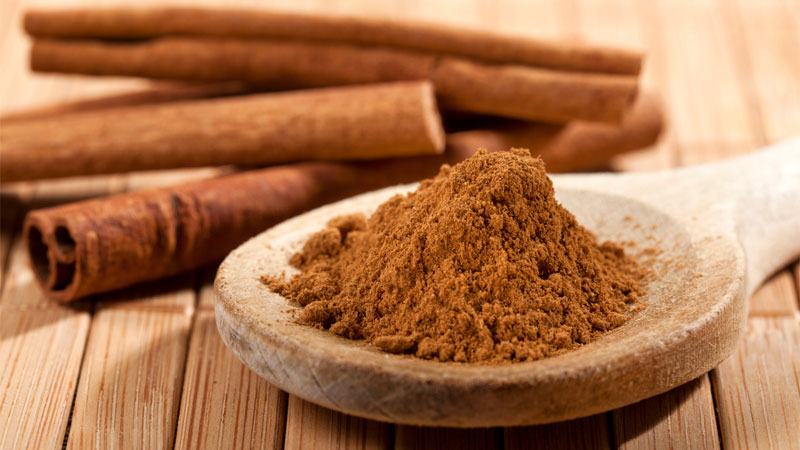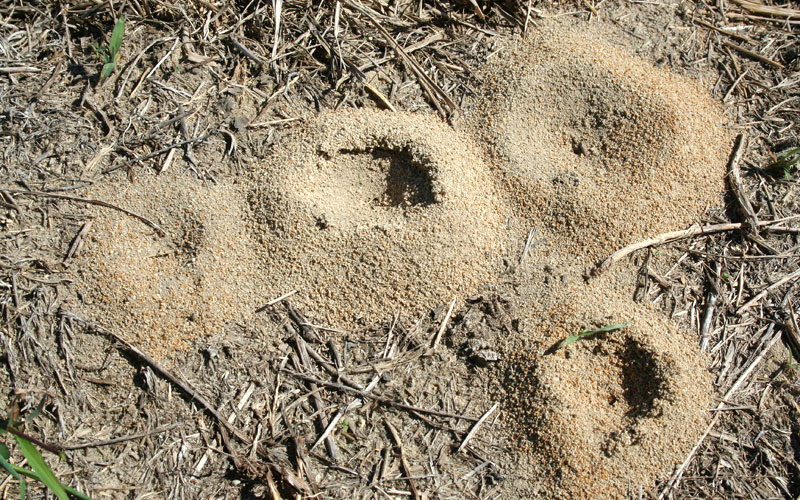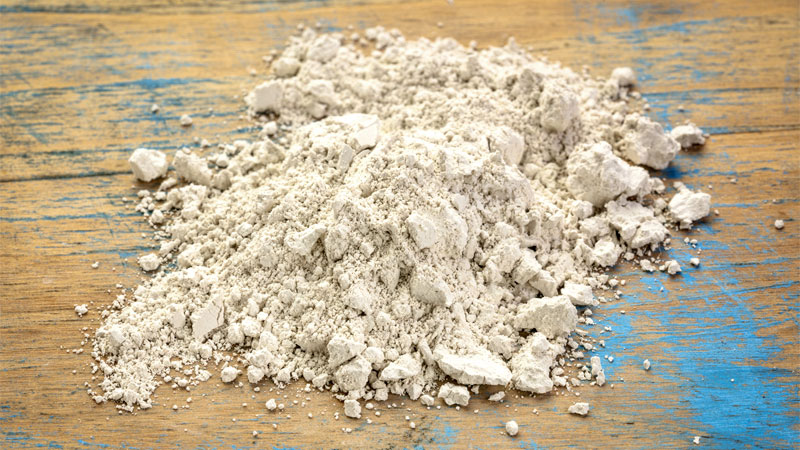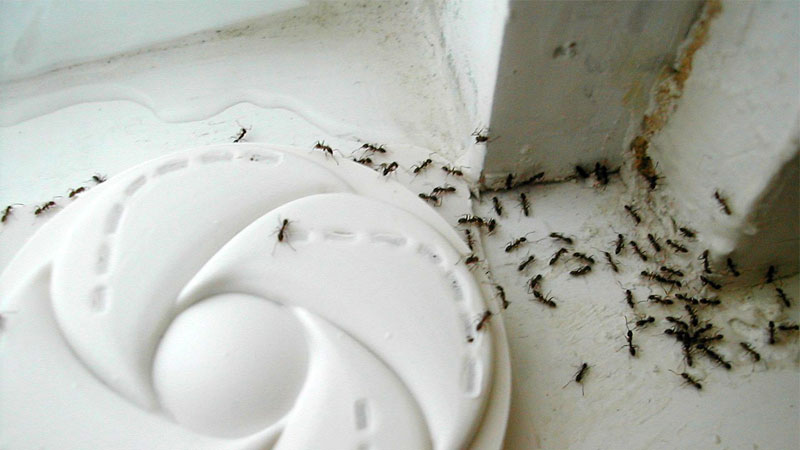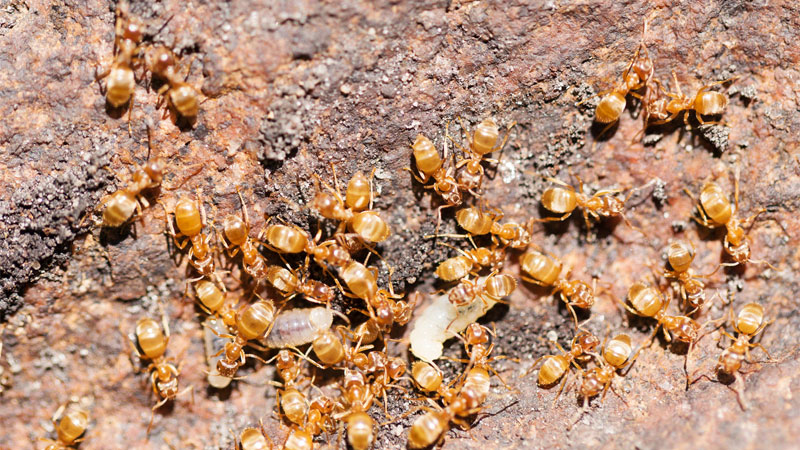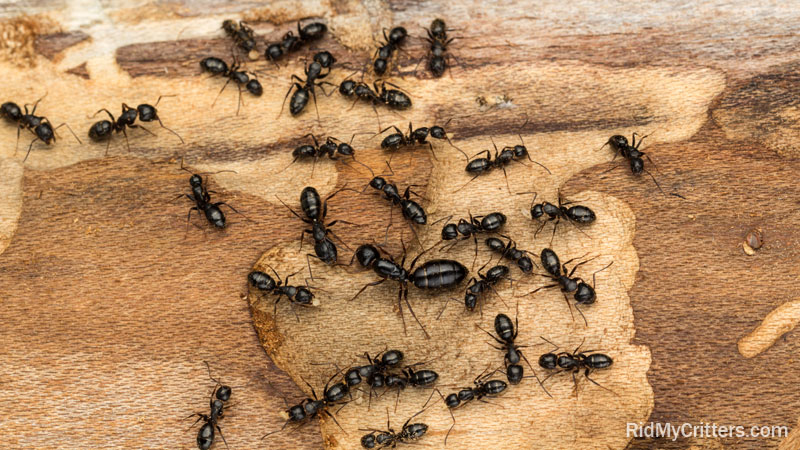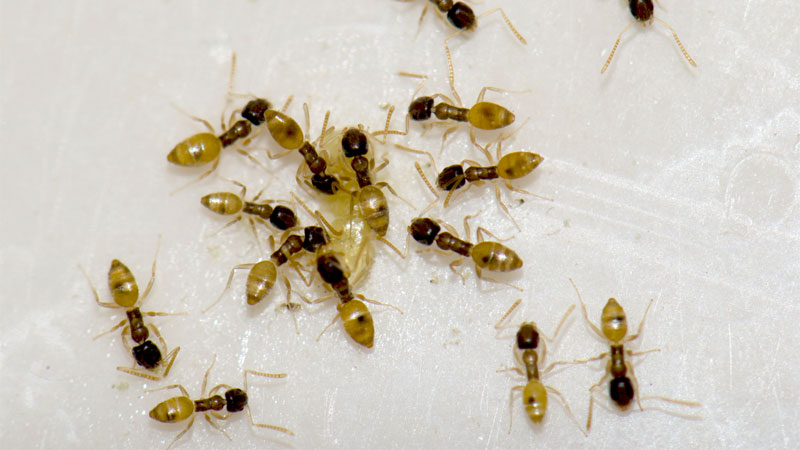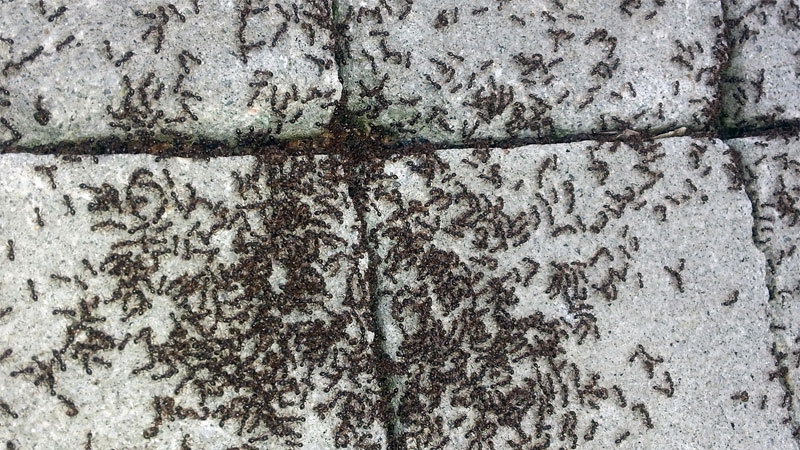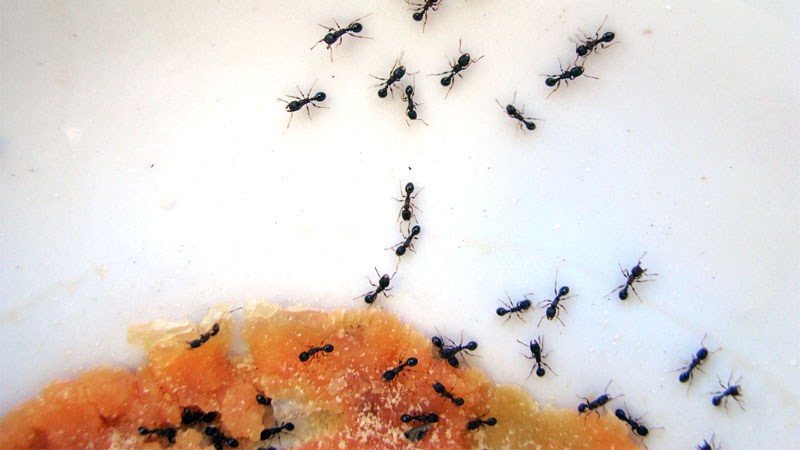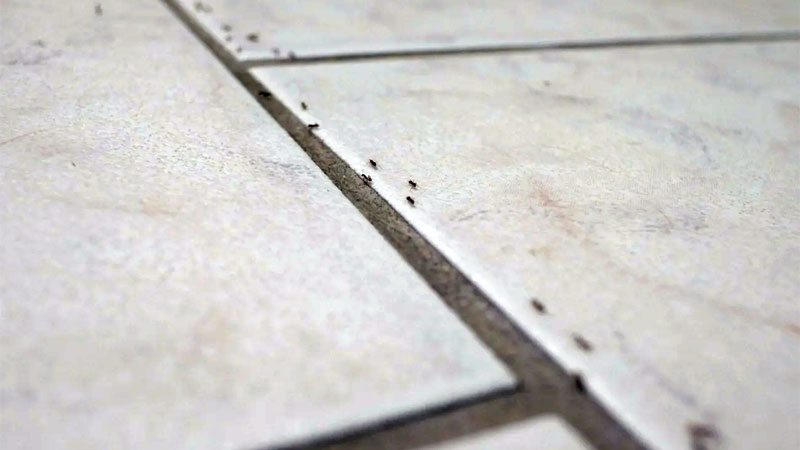You’ve probably heard of people referring to sugar ants before and pictured tiny black ants running away with sugar crystals, but this is only the beginning of the story.
In fact, once you get to know them, getting rid of sugar ants becomes fairly easy.
How to Get Rid of Sugar Ants
So you’ve identified sugar ants, understand how they behave, and have found their colony. It’s time to take care of the problem. Let’s begin with the easy route, then look at DIY methods for dealing with with indoor and outdoor nests.
What Is the Fastest Way to Get Rid of Sugar Ants?
Different species must be handled in different ways. It’s generally believed that a solution of equal parts white vinegar and water can kill ants the fastest, but this method can also send super colonies into high alert.
The best way to get rid of sugar ants quickly without alarming a super colony is to hire an exterminator. However, there are slower methods that may prove far more affordable and just as effective in the long run.
How to Kill Sugar Ants Indoors
There are several methods you can employ to eliminate sugar ants from your home, although it’s important to first identify the type of ant. The following methods will list whether or not you may use that method safely against super colony ants.
#1 – Bait Traps (BEST OVERALL METHOD)
Usable Against: Super colonies, regular colonies.
Few things are as effective against ants as a good bait trap. In fact, this is perhaps the most effective way to combat super colonies.
Commercial Bait Traps
You can buy commercial traps, but it’s important to check the label carefully to ensure it will work against your particular ant problem. You will also need to switch brands occasionally to prevent the colony from building up a resistance.
- Attracts & Kills – Kills common household ants including acrobat, crazy,...
- Kills the Ants You See & the Ones You Don't – As worker ants discover the...
- Works Fast – You should see a significant decrease in the number of ants...
Homemade Bait Traps
The good news is that you can also make your own homemade baits. Perhaps the easiest one is to mix equal parts of boric acid and either peanut butter (protein) or jelly (sugar). Drip small amounts of this on bits of parchment paper and place them along the ant trails.
Borax, the raw version of boric acid, can also be used effectively. See “Using Borax to Kill Ants” for specific instructions on how to safely use it.
Boric acid (and borax) eats away at the ant from the inside, but it does so slowly. This means the ants will have time to take the bait back to the colony and share it with others.
Using a protein means there’s a higher chance it will be fed to the queen and larvae. When in doubt, place a bit of peanut butter bait and jelly bait on the same paper bits so the ants will feed on both.
Pros and Cons of Bait Traps
This method is highly effective because it targets the queens and even the larvae. However, the bait kills slow enough that the colony doesn’t realize there’s a problem until it’s already too late.
When using a borax bait, you can not only kill a sugar ant infestation, it will also eliminate cockroach infestations.
On the other side of the coin, boric acid and commercial baits are toxic to both humans and pets. They should thus only be placed where curious hands and paws can’t reach them.
Note that you can use baking soda instead of borax for a somewhat safer bait, although this will still be toxic to birds and some pets.
#2 – Sticky Traps
Useful Against: Super colonies, regular colonies
Glue strips and other forms of sticky trap are commonly used for killing flies, but they’re also great against ants. Simply lay your glue traps sticky side up along places you’ve seen foraging columns. The ants will get stuck and die.
This method won’t alarm a super colony, but it also doesn’t target the queen. Don’t use near kids or pets (unless you’re ready to peel the super sticky strips off).
- Say Goodbye to Bugs – Traps and kills spiders, ants, roaches, centipedes, and...
- Kills the “Big 3” – These traps also capture dangerous spiders, including...
- Versatile Design – These easy-to-use traps can be deployed flat or folded. Use...
#3 – Soapy Water
Usable Against: Regular colonies
Soapy water is a tried ad true method, but you don’t have to go overboard. A single teaspoon of soap per quart or tablespoon per gallon will do. This can be insecticidal soap, or (if you want a less toxic version) either Dawn dish liquid or pure castile soap. Pour into a spray bottle and shoot the little buggers.
This homemade ant killer can cause super colony ants to panic, and it only works on direct contact. However, it’s an effective killer, suffocating the target without being toxic to humans or pets.
It’s also safe for use on most plants. However, as this method doesn’t target the queen, it’s best used when outdoor ant colonies send foragers indoors.
#4 – Vacuuming/Steaming
Usable Against: Regular colonies
Your vacuum cleaner is a valuable ally in the fight against many tiny critters, including ants. Simply turn it on and suck up the column, then discard the bag. Using a steamer is even better, because it will kill the ants on contact, preventing any possibility of escape.
The great thing about this method is it also keeps the house clean. Unfortunately, it won’t target the queen, so it’s only a means to control the ant population. Additionally, this method will set super colonies on alert, so make sure you’re dealing with a single queen species.
Does Cinnamon REALLY Kill or Repel Ants?
This is one of those old wives’ tales that has a basis in fact. Some claim that the cinnamon suffocates ants, but this is unlikely to work against smaller ants unless you’re literally dumping finely (and we mean VERY finely) ground cinnamon directly onto the ant. The chances of it working on tiny ants (such as most sugar ant species) is practically zero.
So why is this myth so popular? It turns out that the method originated in an article from the International Journal of Scientific and Research Publications about a laboratory experiment that tested concentrated oils from cinnamon on ants.
This 2014 article explained the oils had some effect at repelling ants, but again, this was a concentrate cinnamon oil, not powdered cinnamon.
As a repellent, cinnamon can cause ants to divert their path, as the strong smell overrides the ants’ chemical trails. However, the foraging ants will simply try to get around the cinnamon or find somewhere else to forage. Thus, this method is best used to guide ants towards a bait trap while temporarily blocking access to a previous food source.
Read Also: Does Salt Kill or Repel Ants?
How to Get Rid of Sugar Ants Outside
Fighting ants outside means different obstacles than indoors. You won’t have to worry about structural damage, but plants, rain, and wind are now problems.
That said, some of the methods we’ve already mentioned will work outside, and there are several new options at your disposal.
#1 – Indoor Methods that Work Outdoors
Bait traps remain the single most effective option, although rain can cause the bait to wash into the soil and potentially contaminate it. Also, there’s a chance of birds, squirrels, or other critters getting poisoned.
Soapy water is another great option, and you can add a tablespoon of pure neem oil to make a soil soak that will immunize plants against piercing and chewing insects, destroy harmful nematodes, and can even kill ants inside their colonies (including super colonies) as the solution soaks deeper into the ground.
#2 – Boiling Water
Useful Against: Normal colonies
Of the many remedies we’ve discussed, this can be one of the most dangerous, but there’s no doubt it’s effective. You will first need to find an ant mound. Remember, there are different types, and not all will look like little volcanoes.
Don some protective clothing and grab a large pot of boiling water. Slowly and very carefully pour the boiling water over the entrance. As it soaks down, the water will instantly kill every ant it touches, and even when it’s cooled off, it will drown those ants that aren’t cooked.
What makes this so effective is that it targets the entire colony in a vertical column. However, it will only destroy a portion of super colonies and cause a panic. Multiple pots poured over multiple holes will do a lot of damage but if even one queen escapes, the colony will come back.
Another major concern is that you aren’t the only one at risk of getting scalded or burned. Any plant roots touched by the water will be instantly destroyed, meaning your lawn or garden will sustain damage.
#3 – Diatomaceous Earth (DE)
Useful Against: Super colonies, regular colonies
While you can technically use food-grade diatomaceous earth both indoors and outdoors, we’re mentioning it here specifically because it’s more effective against a mound than a column of foraging workers.
Simply sprinkle it around the entrance mounds and it’ll slice and dice any ants that come into contact without alarming the colony.
Sadly, this method won’t target queens and needs to be reapplied every few days or after it rains. But for a safe, non-toxic method, this one is great at population control.
- Natural Product - Composed of 4lbs of 100% ground freshwater diatomaceous earth...
- OMRI Listed - Listed with the Organic Minerals Research Institute, a non-profit...
- Powder Duster Included - Powder duster in the bag for easy and efficient...
Getting to Know Sugar Ants
Sugar ants can be found all over the world and come in all shapes and sizes. Because they’re such a diverse group, we’ll try to give you all the important cliff notes without going overboard on the details.
Common Sugar Ant Species
The term sugar ant doesn’t actually apply to any single species of ant. Instead, it refers to a number of different ants which are known to either invade houses in search of food or actively attempt to nest inside homes. Here are some of the most common types of sugar ant in the US.
Argentine Ants (Linepithema humile)
This invasive species can form massive super colonies that span hundreds or even thousands of miles. While not directly harmful to humans, Argentine ants can do major damage to properties. They’re also connected to the endangerment and extinction of several native animal and insect species.
Acrobat Ants (Crematogaster spp.)
Known for their heart-shaped abdomens, acrobat ants actively hunt a lot of other insects, which can include pollinators. They can also invade homes where they quickly multiply if they find a suitable food source.
Grease Ants (Solenopsis molesta)
Also known as thief ants, these tiny ants are notorious for slipping into the colonies of other ants and stealing anything not nailed down. This can lead to them being seen with sugar ants. However, their primary food preference is actually protein, including greasy human foods.
American Cornfield Ant (Lasius americanus)
Originally thought to be a variation of Lasius alienus, the American cornfield ant will build nests atop buildings but rarely nest indoors. However, they are known to invade homes while foraging and are a popular choice for ant farms.
Carpenter Ants (Camponotus spp.)
While often associated with termites, carpenter ants are unable to digest fresh wood. However, finding a colony in your home is a sure sign that there’s already structural damage they’re taking advantage of.
Little Black Ants (Monomorium minimum)
These tiny ants are less problematic than most other sugar ants and tend to have somewhat smaller colonies. However, while little black ants nest exclusively in the soil, their small size means they often forage inside homes using tiny entry points.
Ghost Ants (Tapinoma melanocephalum)
Found mostly in the southern states, ghost ants are one of many species of sugar ant to have multi-queen, budding colonies. While preferring honeydew for their diet, it’s not unusual for these tropical ants to invade homes and set up satellite colonies indoors.
Odorous House Ants (Tapinoma sessile)
These ants are surprisingly tolerant of other species and will even share their colonies. They get their name (as well as the nickname coconut ant) from the rotten coconut smell they give off when crushed.
See Also: Does Coconut Oil Attract Bugs?
Rover Ants (Brachymyrmex spp.)
Rover ants are quite small and generally more annoying to botanists (discerning each species is very difficult) than people. However, these sugar ants are also attracted to moisture and mold, so if they invade your home, it’s not a good sign.
Pavement Ants (Tetramorium spp.)
Pavement ants are most commonly found living under sidewalks and rocks, but can also invade homes.
Pharaoh Ants (Monomorium pharaonis)
Pharaoh ants are tiny and light brown, yet their multi-queen colonies allow these ants to spread quickly. A single seed colony is capable of infesting an entire office block, causing extensive damage to organics (such as rubber or textiles) and are especially prevalent in hospitals.
Winter Ant (Prenolepis imparis)
Also known as the false honeypot ant, this curious species didn’t get the memo that opposite day isn’t all year long. They like cool temperatures and hibernate in the summer, only entering homes when foraging or accidentally during mating flights. They’re also one species of sugar ant you shouldn’t kill.
What Causes Sugar Ants In Your House?
Some sugar ant species will enter your home while expanding their colonies or accidentally wander in. However, the two things that will make them stay are sweet foods and water sources.
Despite the nickname, these ants will also be attracted by greasy foods and protein, especially grease ants.
In other words, if you have a lot of food debris in your home or on a porch or patio, you have a very high chance of getting a sugar ant invasion.
Where Are They Coming From?
This can be a more important question than it first seems. Sometimes, you’re only seeing foragers taking food to a colony outside. But sometimes the entire colony is inside your home.
We’ll discuss this in more detail later on, as knowing where the colony is located can play a huge role in fighting off the ants.
Do Sugar Ants Bite?
Most sugar ant species are too small to bite or sting. In rare cases where they’re large enough, they are likely very mild bites. It’s also very likely you will only get bitten by a single ant, unlike situations where you’re facing fire ants or other more aggressive species.
Are Sugar Ants Dangerous?
Generally speaking, sugar ants tend to be more of a nuisance than a threat. However, they can contaminate food they come into contact with. Additionally, the presence of carpenter ants or rover ants suggests there could be serious structural issues in your home, such as rotting wood or mold.
Finally, many types of sugar ant are known to nest in insulation or be attracted to electrical boxes and wires, which could pose a fire hazard and costly electrician bills.
How to Find a Sugar Ant Nest
Humans tend to take pride in having evolved to a more civilized state, but when it comes to ants, you have to let that go and embrace the inner hunter. Get close to a column of ants and start following them away from their food source. Resist the urge to squish them, as this can send some colonies into a breeding frenzy and some species really stink when crushed.
Instead, follow the column until you see them going in and out of a wall, crack in the floor, etc. If it’s an outer wall and you’ve identified this as a primarily outdoor species (or aren’t sure), slip outside and try to spot the column on the other side of the wall. If you find it, follow the trail back to the colony entrance.
However, if the column is going into an inner wall, you can’t find it outside, or you’ve identified it as a species that nests indoors, you will have to address it immediately and may need to call in professionals.
Key Considerations
Many types of sugar ants behave differently than one might expect. As a result, these two common questions are important enough to warrant their own section.
Will Sugar Ants Go Away on Their Own?
Contrary to what we were told as kids, ignoring a problem doesn’t make it go away, it can actually make it worse. This is especially true of sugar ants.
Ants that build their colonies outdoors will continue to invade your home if they’ve discovered the kitchen or another source of food. And the more food they take back, the bigger the colony will get and the more workers they’ll send inside.
Even worse, ants that have set up satellite colonies in your home will continue to expand and may cause extensive structural damage. This includes chewing through drywall and insulation or damaging electrical wires and junction boxes.
Does Killing Ants Attract More of Them?
Believe it or not, this is an incredibly important question. Some sugar ant species have the usual colonies with one queen. The good news with these sugar ants is that you can kill to your heart’s content with no consequences.
But many others, such as Argentine ants, live in societies with multiple queens and satellite colonies. When a number of ants are suddenly killed, it sends the remaining workers into a panic, putting the entire colony on high alert. The queens then begin laying eggs at a faster rate, causing a population explosion. As a result, stomping on a few ants will indeed attract more.
How to Keep Sugar Ants Away
There are only two ways we really recommend for keeping these ants from coming back (or invading in the first place).
That’s not to say there aren’t more. In fact, we list several on other related articles. However, because we’re talking about a wide range of species with different social structures and habits, it’s hard to find methods that work against ALL sugar ants equally well.
#1 – Exclusion
You can’t have a pest control article without discussing exclusionary tactics. Ants get into your home through all sorts of cracks and crevasses, known collectively (and descriptively) as entry points. Addressing these weaknesses in your home’s defenses will practically eliminate the risk of pest infestations (and greatly reduce your electric bill at the same time).
Begin by replacing any damaged screens and ensuring your doors and windows are properly caulked. Seal any cracks or holes in your foundation and walls, including places pipes or wires enter. Install barriers on vents and other potential entrances.
If you want to get fancy, you can use colored smoke to detect leaks, although this isn’t an easy trick to master. Finish up by creating a death zone around your foundation using a barrier insecticide such as Terro Perimeter Ant Bait.
- Attracts & Kills - These granules bait and kill ants, cockroaches, crickets,...
- Long Lasting - The weather-resistant granules provide long-lasting protection...
- Keeps Insects Out - These outdoor granules take care of insect infestations...
#2 – Companion Planting
Companion planting is a trick that lets you plant more things in a smaller space while eliminating the need for pesticides, herbicides, or other chemicals. It also attracts beneficial critters while repelling nastier ones, from ants and aphids to deer and rabbits.
To repel ants, use strongly scented flowers and herbs, such as alliums, lavender, marigolds, mint, rosemary, or sage. These plants add beauty to your property, are often edible, and ants will try to avoid them.
A plant barrier will also discourage most sugar ants who traditionally thrive off of honeydew.
- How to Get Rid of Hawks - March 8, 2024
- How to Get Rid of Pill Bugs (Rolly Pollies) - March 1, 2024
- How to Get Rid of Groundhogs (Woodchucks) - February 5, 2024
